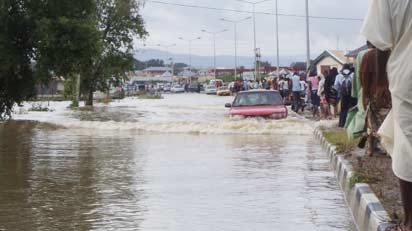The Interior Ministry in Niger said flooding had killed at least 56 people since the rainy season began in the country in June and left over 185,000 homeless.
In one of the world’s poorest countries, where most houses are made of earth or mud, the flood destroyed thousands of homes.
One of the flood victims, Mahamane Soumana, said his home and farm had been completely flooded for the past two months.
Soumana, who stood ankle-deep in mud, hesitatingly throwing a net in his home’s flooded yard in Banga Bana district, in Niamey, his two houses collapsed with the rain.
“I‘m a rice farmer, not a fisherman, but my field has been completely flooded for the past two months. So, I fish in my courtyard.
“I used to have two houses, both of which collapsed with the rain.
“But, now I have nothing to house or feed my family other than fish,” he told Thomson Reuters Foundation as he tried to untangle a couple of small fish from his net.
Soumana’s situation is far from uncommon. For Nigeriens unable to afford cement homes, each rainy season increasingly brings a dangerous ordeal, local experts say.
According to Katiellou Gaptia, Head of Meteorology at Niger’s Met Office, climate change in the Sahel is creating warmer conditions where the atmosphere can hold more moisture, often increasing the volume of rainfall.
“This year’s rain is just extraordinary. In Niamey alone, the season’s rainfall has increased by 84 percent since 2010,” he said.
Gabagoura, a village northwest of Niamey, is one of the worst affected areas by the recent floods.
On the median strip of the main road, mats and foam mattresses dry on guardrails.
Around them, piles of wood and straw are all that are left of more than 290 homes that collapsed at the end of August, leaving 1,200 people homeless.
Village chief, Adamou Saley, walks towards a massive silk-cotton tree, under which 15 people have taken shelter.
“Look at this misery, total desolation,” he said, looking around at the remnants of homes.
Saley said Gabagoura village had indeed been warned by the government on television and radio.
“But, the village was spared the brunt of flooding last year, so people thought they would be safe.
“Some still tried to build drainage gutters around their homes, but even they collapsed,” said the village chief.
He said that the government and several non-governmental organisations had sent food and supplies and that some flood victims had moved into the village’s two schools.
“But some people are still left on the streets. School is set to start again in early October, which may mean those sheltering in schools will need to find a new place to stay.
“If we don’t get any more help I don’t know what will happen to those currently living in the school,” Saley said.
He expressed apprehension over more predicted rainfall, saying “80 per cent of us are without homes. If it rains again, we’ll lose the entire village.’’
Hadjara Yacouba’s house was entirely destroyed by the rains.
She said “we have nothing, not even a tent.
“I am a widow with 17 children, and we have lost everything.’’
“Before the start of the rainy season, the government advised people living in flood-prone areas to leave their homes.
“But few heeded the advice because they refused to abandon their homes or had nowhere else to go,’’ said Boubacar Sidikou, Secretary-General for Niger’s Ministry of Humanitarian Action and Disaster Management.
“As soon as we have the funds to prepare the shelter sites we will do so.
“We believe the shelters will allow us to temporarily house all those currently left in schools,” Sidikou said, without specifying how many people the sites could accommodate.
Fatima Alher, who heads a project mapping flood-prone zones in Niamey, thinks national and local efforts to prepare for flooding were not enough.
“To date, we’ve not had an efficient system to alert the entire population.
“Flood survivors we spoke to said they weren’t properly informed of what was happening,” she said.
Today, efforts to rebuild flood-stricken areas are not progressing fast enough, residents complained.
Officials at the Ministry of Humanitarian Action and Disaster Management said they had identified four potential shelter areas in Niamey, but had yet to set them up due to lack of funds

